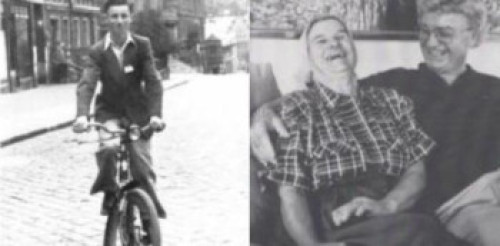Art of Remembering: Student Art Contest Honoring Holocaust Survivors
The Art of Remembering: Student Art Contest challenges students to explore the history and personal stories of the Holocaust and to consider how these stories connect to our lives today.
Open to students in grades 5-12 from Washington, Idaho, Montana, and Alaska.
The Holocaust Center for Humanity's Art Contest is offered in memory of Jacob Friedman, a Holocaust survivor who recognized the incredible value of education. (Read more about Jacob Friedman below.)
Prizes are awarded in two categories:
- Category 1 - Grades 5-8
- Category 2 - Grades 9-12
Thank you to all who participated in this year’s contest! This year, we were honored to have 175 entries from 15 schools across the Pacific Northwest. Entries explored the lives of over 48 local Holocaust survivors through art.
Explore our 2024 Winners Booklet for a look into all the award-winning works!
Navigate directly to a subtopic:
2024 Prompt | Grade 5-8 Winners | Grade 9-12 Winners | Previous Winners
Prompt
Background:

It was 1944 and Henry Friedman was 15 years old. For 18 months, he had been hiding in the tiny cramped loft of a barn with his mother, brother and teacher, while the Nazis and their collaborators hunted every Jewish person. Finally, the Nazis fled, and it was safe for them to come out. Emaciated, starving, and having lost so much, Henry, along with his brother and parents were the only Jewish family from the city of Brody, Poland to survive the Holocaust.
Now, 80 years later, on the anniversary of Henry's liberation, Henry continues to tell his story of surviving the Holocaust, owing his survival to the remarkable actions of Julia Symchuk, a non-Jewish teenage girl and her family that risked their own lives to hide him.
Henry Friedman, whose story is one of many featured in our "Survivor Encyclopedia: Washington State", founded the Holocaust Center's art contest in honor of his father, Jacob, who instilled in Henry at a young age the importance of education. Through lessons of the Holocaust, we learn the importance of standing up for others, speaking out against hatred, and that each person can make a difference.
Photos: On left, Henry Friedman one year after liberation, 1945, Galicia, Poland. On right, Julia Symchuk reunited with Henry Friedman in Seattle, WA 1989.
Prompt:
Choose one or more of the Holocaust survivor profiles from the "Survivor Encyclopedia: Washington State." In the art form of your choice, convey one local survivor story, or a piece of that story, which inspires or stands out to you. In your artist's statement of 125 words or less, tell us why you chose the story, image, or scene that you did.
Please read the prompt and the rules carefully. Please see the rules for details on the sizes of items and types of items that we accept. Entries that do not follow the rules or that don't answer the prompt will not be judged.
Grade 5-8 Winners

1st Place:
Amishi Ahuja,
Grade 8,
Redmond Middle School,
Redmond, WA
2nd Place:
Yael Stewart,
Grade 7,
Lake Washington Girls Middle School,
Seattle, WA


3rd Place:
Aleena Unnikrishnan,
Grade 8, Brier Terrace Middle School,
Brier, WA
Honorable Mention:
Yu-bin Bae,
Grade 6,
Lakeside Middle School,
Seattle, WA

Grade 9-12 Winners

1st Place:
Likitha Nanduri,
Grade 12,
Tesla STEM High School,
Redmond, WA
2nd Place:
Hunter Kim,
Grade 9,
Studio S Fine Arts,
Bellevue, WA


3rd Place:
Ellie Wineinger,
Grade 9,
Freeman High School,
Rockford, WA
See Previous Winners
See the winners of the Holocaust Writing, Art & Film Contest 2023
See the winners of the Holocaust Writing, Art, & Film Contest 2022

